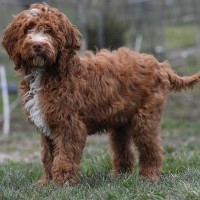Appearance of the Brittnepoo
|
| The Brittnepoo is a medium-sized dog that is elegant and squarely built. It has a long muzzle, rounded skull and slight stop. The broad ears hang close to the head and are supple. The nose has large nostrils and comes in various shades from beige to brown, dark pink or even black, depending on the coat color. The teeth meet in a scissor bite. Brittnepoo eyes are oval and dark in color. The body is athletic and well-shaped, with long, straight front legs and small, round paws with well arched toes and thick pads. The tail is set high and is naturally short or docked to 10 centimetres or less (in Europe, it is illegal to clip tails). The dewclaws are sometimes removed. The Brittnepoo line may have feathers on the legs. |
Temperament of the Brittnepoo
|
| The Brittnepoo is a dog that wants to please, and has a sensitive side to its nature. When training this breed, use firm but friendly language and reward achievements with lavish praise and small treats. These dogs have lots of energy and will join you for a walk or a game. When walking the dog, keep him on a leash as he can wander off following his nose, leaving you behind. These are intelligent dogs who learn quickly and respect a strong leader. Socialize puppies well to ensure they are good with children and other pets. These dogs need mental stimulation and physical exercise to stay happy and healthy. They can become hyperactive and unstable if they don't get the exercise they need. The Brittnepoo is an affectionate dog but has a little independence, but is generally very good-natured and easy to look after. Their enthusiasm for a walk or a game will put a smile on your face - they just love life. |
Needs and activities of the Brittnepoo
|
| The Brittnepoo comes from a line of active parent dogs, so it inherits this trait. They love to walk or run every day, and enjoy active family play. They love retrieving a ball, splashing in water or taking on the challenge of an obstacle course. Brittnepoo are highly intelligent dogs who enjoy mental challenges. If you have a fenced-in yard, they'll stay happy with one eye on you to see what you're up to. They are people dogs and love to be part of the family scene. Although they can be kept in an apartment, they need daily exercise to succeed. And by exercise, I mean a challenging walk or run, or games where they have to fetch the ball. You need to use that energy so they're happy to rest once they're indoors. These dogs need to cover an average of 10 kilometers a day. |
Maintenance of the Brittnepoo
|
| Brittnepoo care and maintenance depends on the predominance of the Poodle's influence on your dog. Usually, the hybrid breed has a combination of the dense, soft single coat of the lightly feathered Brittany Spaniel, with the fine, curly coat of the Poodle. It will need regular brushing every other day just to keep it from matting. Trimming may be necessary to keep him in shape, especially if your Brittnepoo tends to carry the Poodle coat. Although this dog doesn't require frequent washing, be sure to use a sensitive dog shampoo to keep the skin healthy. Dental care is particularly important, so teach your dog when he's young to have his mouth examined and his teeth brushed. If your dog has been out exploring, check the inner ear to make sure there are no seeds trapped in the ear to cause inflammation. A nail trim every two weeks should keep your dog in perfect health. |









 English (United Kingdom)
English (United Kingdom)